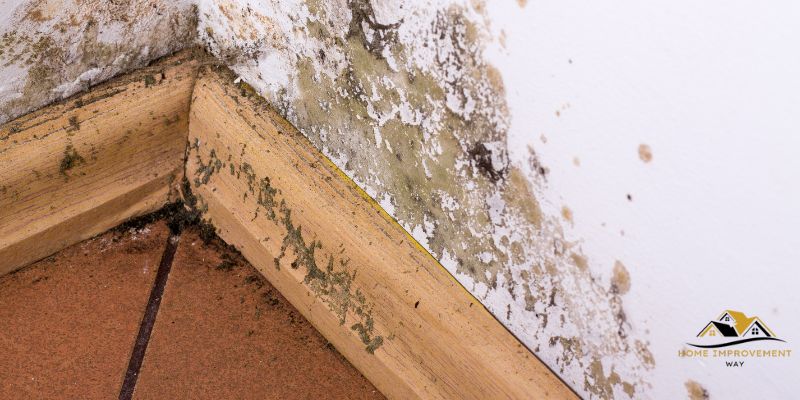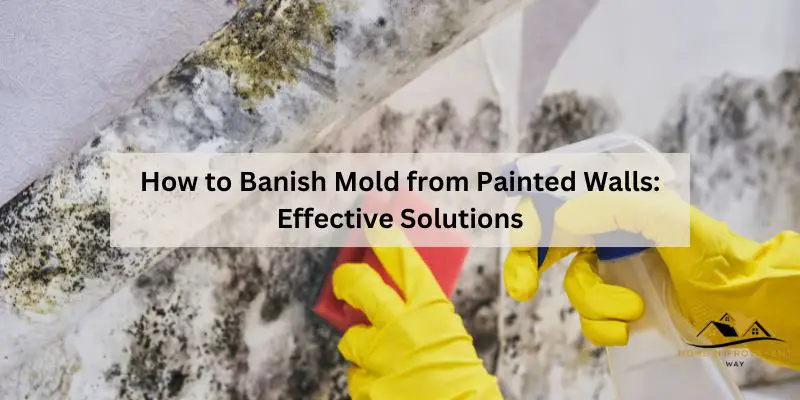To remove mold from painted walls, mix equal parts of water and bleach, and use a scrub brush to clean the affected areas thoroughly. Mold can be a common problem in homes, especially in areas with high humidity.
If left untreated, it can cause health issues and damage to your painted walls. Fortunately, removing mold from painted walls is a relatively simple process. By following a few steps, you can effectively eliminate mold and prevent future growth. In this guide, we will outline how to remove mold from painted walls, providing you with the knowledge to tackle this issue head-on.
Keep reading to learn more.
Clarity The Dangers Of Mold On Painted Walls
Mold growth on painted walls may not only be unsightly but also pose various risks to your health and the structural integrity of your home. It is essential to address mold issues promptly to safeguard your well-being and prevent further damage. In this article, we will discuss the potential health risks associated with mold on painted walls as well as the structural damage it can cause.
Potential Health Risks
Mold on painted walls can have severe implications for your health, particularly if you or your family members are sensitive or prone to allergies. Here are some of the common health risks associated with mold:
- Allergic reactions: Mold spores in the air can trigger allergic reactions, including sneezing, coughing, stuffy nose, itchy eyes, and skin irritation.
- Asthma and respiratory issues: Individuals with asthma may experience worsened symptoms when exposed to mold. Mold can also cause respiratory problems in otherwise healthy individuals.
- Headaches and fatigue: Exposure to mold can lead to persistent headaches and chronic fatigue, impacting your overall well-being.
- Immune system suppression: Prolonged exposure to mold may weaken your immune system, making you more susceptible to infections and illnesses.
To maintain good indoor air quality and protect yourself and your loved ones, it is crucial to address mold growth on painted walls promptly and effectively.

Damage To The Structure
Mold not only affects your health but can also cause significant damage to the structure of your home. Here are some ways in which mold can harm your painted walls and the overall integrity of your property:
- Paint deterioration: Mold growth can cause paint to peel, crack, or bubble, compromising the appearance and protective function of your walls.
- Structural decay: Mold can gradually eat away at the materials beneath the painted surface, weakening the structural integrity of your walls and potentially leading to costly repairs.
- Stains and discoloration: Mold can leave unsightly stains and discoloration on your painted walls, making them unappealing and difficult to clean.
- Unpleasant odor: Mold-infested walls often emit a musty and unpleasant odor, which can be persistent and difficult to eliminate.
Regular maintenance and prompt mold remediation are crucial to preserve the aesthetic appeal and structural stability of your home.
Identifying Mold On Painted Walls
Identifying mold on painted walls is crucial for effective mold removal. Mold can thrive in damp, humid environments, causing potential health risks and damage to your home. By knowing what to look for, you can catch mold growth early and take appropriate steps to address the issue.
Visible Signs Of Mold
One of the most obvious signs of mold on painted walls is the visible discoloration. Mold can appear as black, green, or brown patches that spread across the surface. If you notice any unusual spots or irregularities on your walls, it is essential to inspect them for possible mold growth. These patches are usually accompanied by a fuzzy or slimy texture.
Musty Odor
Another way to identify mold on painted walls is through the characteristic musty odor it produces. Mold releases volatile organic compounds (VOCs) that emit a distinct earthy smell. If you frequently notice a musty odor in a particular room or near a certain wall, it could be an indication of mold. This smell is often described as damp or stale.
It’s important to note that not all mold is visible or produces a noticeable odor. Sometimes, mold can be hidden behind wallpaper, drywall, or other surfaces. If you suspect mold but cannot see any visible signs or detect an odor, it may be necessary to consult a professional for further investigation.
By promptly identifying mold on painted walls, you can prevent its spread and mitigate any potential health risks or damage. Once you have confirmed the presence of mold, it is crucial to proceed with the appropriate steps for removal and remediation. In the following sections, we will explore effective methods for removing mold from painted walls.
Effective Solutions For Removing Mold From Painted Walls
Remove mold from painted walls with effective solutions. Learn how to safely eliminate mold growth for a clean and healthy living space.
Mold growth on painted walls can not only be unsightly but also pose health risks. To effectively tackle this problem, it is essential to follow the right steps. In this guide, we will explore simple yet effective solutions for removing mold from painted walls. By preparing the area, using mold-killing solutions, and taking preventive measures, you can ensure a mold-free environment for your home.
Preparing The Area
Before you begin the mold removal process, it is crucial to prepare the area properly. Follow these steps to ensure a safe and efficient cleaning experience:
- Cover the floors and furniture with plastic sheets or old newspapers to protect them from any potential damage or spores.
- Wear protective clothing, gloves, a mask, and safety goggles to safeguard yourself from mold spores and cleaning solutions.
- Open windows and use fans to improve ventilation, allowing fresh air to circulate in the room during and after the cleaning process.
- Remove any belongings, such as pictures or decorations, from the affected wall to prevent further contamination.

Using Mold-killing Solutions
Once the area is prepared, it’s time to eliminate the mold from the painted walls. Here are effective mold-killing solutions to restore the cleanliness of your walls:
| Ingredients | Instructions |
|---|---|
| Vinegar solution | Mix equal parts of white vinegar and water in a spray bottle. Spray the solution on the molded area and let it sit for an hour. Scrub gently with a soft brush and wipe clean with a damp cloth. |
| Bleach solution | Dilute one part bleach with three parts water. Apply the solution to the affected area and let it sit for 15 minutes. Scrub with a brush and rinse thoroughly with water. |
| Hydrogen peroxide solution | Mix one part hydrogen peroxide with two parts water. Spray or apply the solution to the mold-infested area and leave it for 10 minutes. Scrub gently and wipe clean with a damp cloth. |
Remember to test these solutions on a small, inconspicuous area of the wall first to ensure that they don’t damage the paint. Additionally, never mix bleach with other cleaning substances, as it can release harmful fumes.
Preventing Future Mold Growth
After successfully removing mold from your painted walls, it’s crucial to take preventive measures to avoid its recurrence. Follow these steps to keep your walls mold-free:
- Monitor and control indoor humidity levels, keeping them below 50 percent to discourage mold growth.
- Fix any leaks or water-related issues, such as dripping pipes or roof leaks, promptly.
- Improve ventilation in areas prone to moisture, such as bathrooms and kitchens, by using exhaust fans or opening windows.
- Regularly clean and dry areas susceptible to moisture, including shower walls, windowsills, and basements.
- Consider using mold-resistant paint for a protective barrier against future mold growth.
By preparing the area, using effective mold-killing solutions, and implementing preventive measures, you can efficiently remove mold from painted walls and halt its reappearance. Remember to prioritize safety by wearing protective gear throughout the process. With these solutions in hand, you can restore the cleanliness and health of your living space.
Conclusion
To sum up, removing mold from painted walls requires a systematic approach to ensure effectiveness and prevent its recurrence. By using a combination of natural cleaning solutions, proper ventilation, and regular maintenance, you can successfully eradicate mold and maintain a healthy living environment.
Remember, taking immediate action and addressing the root causes of mold growth are key to preventing future problems. With these tips, you can confidently tackle mold removal and restore the beauty of your painted walls.

